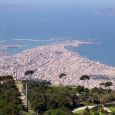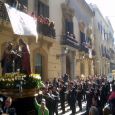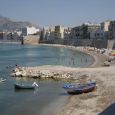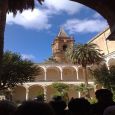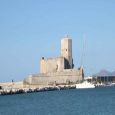Trapani
Advertisement
By Air
Trapani-Birgi Airport a military-civil joint use airport (third for traffic on the island).Recently the airport has seen an increase of traffic thanks to low-cost carriers from all parts of Europe (es. London-Stansted and London-Luton, Paris Beauvais, Dublin, Bruxelles, Munich, Frankfurt, Eindhoven, Stockholm).
By Train
Regarding rail transport there are two lines connecting Trapani to Palermo one which is the shortest route passing through the station while the other Alcamo through the centers of the province in the south before reaching Alcamo the regional capital.The railway station is at the heart of the city allowing easy access to the old town and the harbor.
By Bus
The only example in the entire province Trapani is the only city to have a bus service.The ATM Trapani Transport Company and Mobility (formerly AA) manages the service within the municipality with 12 urban and 3 suburban lines.For mobility within the center uses a number of electric buses (Tom Thumb) that can pass in the Limited Traffic Zone (LTZ).Trapani is the seat of the Sicilian Transport Company (AST) which constitutes together with the See of Palermo the Territorial Structure of Western company.The 14 routes operated by AST connect the capital to infrastructure such as Airport Trapani Airport Trapani-Erice and the cable car at resorts such as San Vito Lo Capo and the hinterland towns of the City.
By Ferry
From the port of Trapani, tourist and shopping you can reach the Islands and Pantelleria Egadi but also the destinations of Cagliari, Tunis and Livorno.Its positioning is central to the Mediterranean, making it ideal hub for commercial traffic and passengers crossing the Channel of Sicily.Its special shape allows you to give the title of Trapani city-port one of the few in Italy.You can distinguish three zones: the first is reserved for passenger traffic, is the one that fits perfectly in the center of the city, the second is made up of the fishing port west of the city and the third is reserved for freight traffic.
By Road
From the city of Trapani Palermo can be reached via the Highway A29: about 97 kilometers separating the two capitals.The highway, a natural continuation of the ring of Trapani, it departs to the east making it possible to reach the inland provincial cities as well as the Palermo-Punta Raisi Airport, about 80 km.The SS 187 and SS 115 respectively allow the connection to the common people from the capital's northern and center of Marsala, Mazara del Vallo and Castelvetrano in the south.The SP 21 connects the capital to Trapani Airport.
Procession of the Mysteries
is a religious event that takes place on Good Friday in many areas of Sicily.From 14.00 on Friday, for nearly four hours takes place in Trapani the majestic procession of the Mysteries.Twenty groups of statues depicting the Passion and Death of Christ made of wood, cloth and glue by the artisans Trapani almost all between the 600 and 700 are carried on their shoulders through the streets of the historic center and the main artery of the modern city via Giovan Battista Fardella in a show of lights, colors and sounds.Noteworthy are also the floral decorations.Each group is sacred in the care of a class (skilled workers).
Agostino Pepoli Regional Museum
is one of the most important museums of Sicily.It houses an important collection of decorative arts, sculptures, including works of Gagini works in coral, silver, sculptures crib and an art gallery which includes, among others, paintings by Titian ( Stigmata of St. Francis ) and Giacomo Balla ( a portrait of Nunzio Nasi ).There are also archaeological findings and historical relics in the province of Trapani.She received in 2008 the exhibition " Caravaggio The image of the divine "in which they were exposed 14 works by the great painter.Since little has been published edited by the publisher Edipuglia the rich catalog on archaeological collections in the Museum.Born in the early twentieth century, is situated in the fourteenth-century convent of the Carmelites adjacent to the Sanctuary of Our Lady of the Annunciation.The first nucleus of the museum comes from the private collection of Count Agostino Pepoli and then with the paintings of the Neapolitan school, donated by Giovan Battista Fardella.After the Second World War is now a museum of the Sicilian Region.
Church of the Souls of Purgatory
is a church in the city of Trapani.Important to the Catholic worship is the home during the years of "Sacred Groups" of the Procession of the Mysteries during Holy Week.Purgatory is located in the Piazzetta.Started in 1688 designed by Don Pietro Lo Castro, while the facade of 1712 is the architect Trapani Giovanni Biagio Amico who is buried in the church.It is divided into two orders and adorned with twelve statues in stone and stucco of the Twelve Apostles of Jesus made by Albert Orlando.The momentum of the central part the higher and lower order motion develops the dynamic effects of the baroque architecture moving away from the fashionable neo-classical dominant.Inside the plant has a Latin cross with three naves.It is no longer open for worship.
Cathedral of San Lorenzo
is the Episcopal Church of Trapani.The Cathedral was built by order of Alfonso the Magnanimous in 1421 and elevated to a parish in the second half of the fifteenth century.Over the following centuries the building was modified several times and the present appearance dates from the restoration of the eighteenth century by the architect Giovanni Biagio Amico.Between 1794 and 1801 were all made of stucco and paint, commissioned by the most renowned artists of Trapani.In 1844 the Cathedral Church is declared, following a bull of Gregory XVI.The dome surrounded by four domes is supported by an original drum square.The plant has three naves divided by two imposing rows of columns in the Sicilian jasper.It preserves a painting of the Crucifixion, painted by Van Dyck a St. George by Andrea Carreco an Eternal Father of Domenico La Bruna and a statue of the Dead Christ, created by James Tartaglia with the stone in the area.Attached to the church is the bishop's palace.
Basilica-Sanctuary of Maria Santissima Annunziata
is a religious building in Trapani dedicated to the Blessed Virgin Mary of Mount Caramel.The first church, S. Mary's birth and assigned to the Carmelites the date 1250.The church built in 1300 and enlarged in the eighteenth century, guards the precious statue in marble Parian of the Madonna of Trapani, a Madonna and Child, by Nino Pisano and landed at Trapani in 1291 revered throughout the Mediterranean.It the most famous Marian shrine in western Sicily.In front of the basilica there is the garden of the Villa Pepoli, now public gardens and on the right side of the Regional Museum Pepoli Augustine, which also contains the Treasury of the Virgin Mary.Ogmi years from 1 August there is the "fifteen" in honor of the Madonna of Trapani, which involves the pilgrims, which ends on 16 with the procession of the statue (now a copy-size).
Tower of Ligny
is an ancient fortress at the western end of the city of Trapani between the Tyrrhenian Sea and the Strait of Sicily.It was erected in 1671 on the orders of the captain general of the Kingdom of Sicily The Moraldo Don Claudio, Prince of Ligny (or lignite) during the Spanish domination of Sicily, on the rocks that form the continuation of the narrow strip of land of the ancient city formerly called Stone Palace.It was built to defend the city from the incursions of Barbary pirates.In 1806 it was made feasible the passage that connected with the earth.Until 1861 the cannons were installed on the roof.During the Second World War was used by the Navy as an anti-aircraft position.Restored in 1979.Built by Carlos De Grunembergh.The square tower narrowing upwards, was equipped with four turrets and masonry originally equipped with lights.Inside there is by 1983 the Museum of Prehistory, prehistoric with the ground floor and first floor room archaeological Navy.
Castle Dovecote
is an ancient fortress on an island at the eastern end of the medieval port of Trapani.It is 32 meters high, consists of four levels, with the first used as a cistern, while the original entrance was on the second floor.It is one of the best examples of military architecture in Sicily.Some legends connect the Dovecote with the Trojan exiles landed at Trapani after the fall of their city in the thirteenth century BC but saw no evidence of this fact.The first historical documents do however was fortified at the time of the First Punic War at the hands of Hamilcar Barca.The tower was named Peliade perhaps because of the herbaceous vegetation that covered the rock on which it was made, which from afar looked like a sea of hair.In 249 BC took place in Trapani a major naval battle which saw the Romans badly defeated by the Carthaginians. Two years later the Roman consul Numerius Fabio Buteone attacked and conquered the island in a single night of the Dovecote killing all its occupants.After the Roman conquest of the tower fell into disuse and was reduced to a nest of doves a fact from which it derives its present name Dovecote.During that period she was probably home to the pagan worship of the goddess Venus Ericina which the doves were sacred animal.
November - March
May - September


